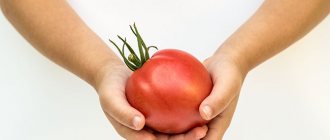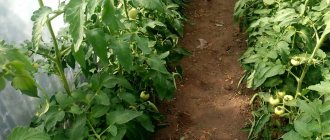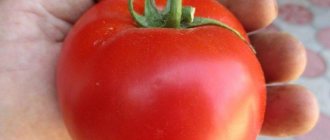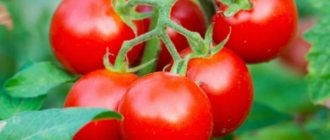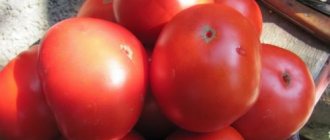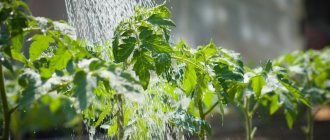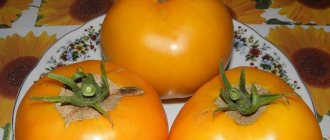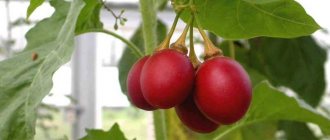The huge fruits that appear on the thin branches of the popular variety are the main difference from other tomato seeds planted in beds. The appetizing Dimensionless tomato is a favorite of summer residents, a delicious giant hidden by a contrasting red skin.
A comprehensive description of the variety does not end with the delight of summer residents from the already ripened fruits. Tomatoes of the Bezrazmerny variety also have a number of advantages that set it apart from its “tomato” counterparts (ease of care, pronounced resistance to dangerous diseases).
General characteristics, differences from other subspecies
Tomatoes in this category fit perfectly into the concept of growing in greenhouses, but the variety is also successfully suitable for planting in open ground. Amazing fruits reach a length of 13-16 cm, and their weight is often more than a kilogram.
The characteristics described below will be understandable for experienced summer residents who want to diversify their routine garden beds with new vegetables and rich red elements of ripe fruits. Tomatoes of this variety:
- determinant (visual criterion);
- large-fruited (the size of a ripe tomato);
- mid-season (fruiting time);
- productive (number of ripe tomatoes per bush).
The graceful stem of neat bushes, overgrown with emerald-colored leaves, grows on average up to a meter. The initial brush begins the process of forming 7-9 greenish leaves above the surface, others appear after 1-2.
The amazing yield amazes novice gardeners, becoming the main topic of dacha discussions between neighbors in their plots. With proper care, just one bush produces 5-7 kilograms of sugary fruits of delicious tomatoes.
Features of cultivation
Tomatoes of this variety can be grown through seedlings or seeds. However, it is still better to give preference to the seedling method, since when growing from seeds, the fruiting time will shift significantly, and the crop may not have time to ripen.
Sowing seeds for seedlings is carried out 65-70 days before planting in the garden. It is optimal to sow in mid-March. Before planting, the seeds are disinfected with a manganese solution.
It is better to plant the seeds already germinated so that the seedlings hatch faster. To do this, the seed material is placed in a damp scarf and left in a dark and warm place for a couple of days. The sprouted seeds are sown in seedling boxes, after which the container is covered with film and the first sprouts are waited for to appear. As soon as the seedlings germinate, the film is removed and the boxes are placed in a well-lit place.
To grow healthy seedlings, you need to keep the seedlings in constant warmth (room temperature 22-25 degrees Celsius). The soil should be moderately moist. The amount of daylight is at least 15 hours.
After two to three weeks, the seedlings are planted in separate containers. Diving is necessary so that the grown tomato bushes find their space and the necessary amount of nutrients for further growth.
Landing in the ground
At the time of planting, tomato seedlings reach a height of 25-35 centimeters. 7-9 leaves are formed on a powerful, stocky stem, and the first cluster is already beginning to bloom. In order for the bushes to take root well in the new soil, they are first hardened off. 10-12 days before the transplantation procedure, the seedling containers are taken out into the fresh air so that the young seedlings get used to the new environmental conditions.
On planting day, you need to make sure that the soil is thoroughly warmed up. The optimal soil temperature is 8 degrees Celsius to a depth of 10-15 centimeters. If planting is carried out in frozen soil, the highly developed rhizome may slow down its growth or even die.
The beds for tomatoes have been prepared since autumn. For deep digging, humus (old manure), compost and mineral fertilizers are added. In the spring, the area is dug up again, adding ash. It is important to thoroughly crush the soil so that old lumps of earth do not interfere with the growth of seedlings.
Seedlings are planted locally in prepared holes, which are pre-diluted with a solution of manganese (for disinfection purposes), superphosphate and ash are added. Each bush is planted vertically, without deepening the rhizome. After which the tomato is sprinkled with earth and lightly compacted so that the stem can stand without support.
It is optimal to plant bushes at a distance of 45-50 centimeters from each other, in a checkerboard pattern (so that each bush is illuminated as best as possible by the sun), placing no more than three plants per square meter.
Care
Caring for tomato bushes begins with establishing reliable support for each bush. It is necessary to tie up not only the stem, but also the heavy clusters, which break due to the weight of the fruit and spread along the ground.
Since many semi-dental varieties do not overgrow much with lateral shoots, dimensionless tomato bushes do not need to be formed. It is enough just to tear off all the lowest stepsons and leaves so that they do not shade the ground under the bushes.
You may be interested in: Dates for planting tomato seedlings in open ground and greenhouses according to the garden calendar Favorable days for planting tomatoes for seedlings in 2021 according to the lunar sowing calendar Favorable days for picking tomatoes in 2021 after germination: timing of picking tomato seedlings in the table by day
But to make maintenance easier and slightly increase productivity, you can resort to shaping the bushes into two or three stems. Without extra shoots and sterile brushes, the plant will be better ventilated, and tying up will not be so troublesome.
To obtain the largest possible fruits, it is recommended to pick off excess inflorescences. This method, of course, will limit the number of tomatoes on the bush, but will increase their quality: they will be larger, juicier and sweeter.
Watering
The tomato variety described responds well to watering. The soil should always remain moist. But not every gardener can achieve the right balance. The frequency of watering is affected by weather conditions. Based on external factors, you can determine when and in what quantity tomatoes need water. In southern regions with hot, dry summers, vegetable beds should be watered every other day. During cloudy periods, once every three days is sufficient.
Please note: it is important to prevent the accumulation of moisture on the surface of the earth, as well as the formation of a dry earthen crust.
Rules for watering tomatoes:
- You only need to water with warm water, as water from the well can inhibit the growth of bushes. The optimal temperature of water for irrigation in warm times is from 18 degrees, and in cold times, if there is a lack of moisture in the soil, it needs to be heated to 25–30 degrees.
- It is necessary to pour water at the root, avoiding drops from falling on the above-ground parts of the plants.
- Greenhouse tomatoes need to be watered less frequently than those grown in open ground.
- Each bush requires up to 4 liters of water daily.
- Compliance with the watering regime is the key to large, uniformly shaped, juicy fruits. Untimely watering can lead to cracking of the fruits and impoverishment of their taste.
Tillage
After each moistening of the soil, the soil should be loosened. This is done so that its pores do not become clogged and the soil does not become compacted. In heavy soil, plants grow very slowly, since air does not reach the depth and the roots are weakened.
To keep moisture in the soil as long as possible, the bed with tomatoes should be mulched. Mulch made of straw or grass perfectly protects the soil from overheating and rapid evaporation of water. In addition, the grass, when rotting, nourishes the earth with its remains, and it, in turn, saturates the roots of the tomatoes with all the necessary nutrition.
You also need to keep the beds clean. The weed, which grows much more intensively than tomatoes, takes all the resources vital for tomatoes from the soil, making its composition more meager. As a result, the tomato bushes do not receive enough nutrition and grow much worse. That’s why it’s so important to get rid of the ubiquitous grass in a timely manner.
Top dressing
To obtain a high yield of large and tasty fruits, plants need to be fed regularly. Timely applied fertilizers nourish the seedlings and accelerate their growth and productivity.
Tomatoes need to be fed correctly, in a timely manner and in doses. The rule “the more the better” does not apply here.
If outwardly the plants look healthy, bloom well and knit, then it is enough to add only three mandatory fertilizing - this will be enough.
Fertilizers are first applied when planning beds. If, during digging, the soil is well saturated with organic matter and minerals, then when planting plants in the hole, neither manure nor superphosphate can be placed. One ash will be enough. Another case is when the land on the site is not fertile: then it would not be a bad idea to feed the plants.
At first, it is better to feed at the root, since the bushes receive their main nutrition from it. 14 days after planting the seedlings, tomato bushes are fed with organic compounds that are rich in nitrogen. For these purposes, urea, fresh manure, compost, and herbal infusions are used. Mineral fertilizers include potassium fertilizers (potassium sulfate).
Fact: The best mineral for any type of soil is superphosphate.
All root dressings are applied carefully, avoiding the mixture getting on the leaves, otherwise they can be burned.
In the intervals between flowering and fruiting, foliar feeding can be done. For this type of fertilizer application, weakly concentrated liquid compositions of minerals are suitable. Plants respond very well to such fertilizing, since a significant amount of nutrients are absorbed through the leaf, and the plant is quickly saturated with useful components.
Foliar feeding can be prepared from several components at once - boric acid, copper sulfate, magnesia, potassium permanganate and laundry soap shavings dissolved in water. This composition will enrich the plants with essential minerals, strengthen all parts of the bush and protect against various ailments.
Feeding during flowering bushes is designed to strengthen the plant's immunity against the occurrence of various diseases. For this, an iodine solution is used. This element promotes the rapid formation and ripening of fruits.
You can use complex compositions, for example, a solution of wood ash and boric acid. In addition to minerals, organic solutions from bird droppings or mullein are also applied under the bushes. If there is not enough organic matter, then it is necessary to add nitrophoska.
During the same period, you can treat the plantings with “green” fertilizer.
During intensive fruiting, it is worth paying attention to elements such as potassium and phosphorus. They must be present in all fertilizer compositions, since it is their effect that will help the fruits become large, beautiful and juicy.
Pest Control
The obvious advantages of the Bezrazmerny variety include its resistance to tomato diseases. But the best protection against disease is prevention. To do this, the bushes are periodically treated with fungicidal and copper-containing preparations.
Among the pests, aphids can often be found on tomato bushes. You can get rid of it only by using insecticidal chemicals.
How to grow
Those who have already planted seeds in pliable soil indicate that it is better to start sowing future tomatoes of the “dimensionless” variety for seedlings 3 months before possible planting in open ground.
See also
Growing, characteristics and description of the tomato variety Crystal F1Read
When planting neat sprouts for a permanent “place of residence,” you should place up to 4 plants per square meter. Those wishing to acquire a harvest with fruits whose size has already reached the generally accepted maximum must carry out the procedure of pinching the inflorescences.
The well-known variety of tomatoes is unpretentious in care, but requires large areas of free space. Therefore, the distance between the sprouts of future bushes should be quite large; it is advisable to carry out pinching.
How to protect tomatoes from late blight, video
You can see other interesting varieties and hybrids of tomatoes with photos, descriptions and reviews in our Tomato Catalog. Enjoy watching.
If you grew Dimensionless tomatoes, please write whether you liked them or not. What was the yield in your climatic conditions? If possible, attach a photo of the entire bush or individual fruits you grew to your comment. Thank you!
Your feedback and additions to the description will help many gardeners evaluate this variety more objectively and decide whether it is worth planting or not.
This is a natural variety of tomato. Therefore, we recommend taking seeds from a ripe fruit and using them for planting in subsequent seasons.
Abundant advantages and rare disadvantages
If you find yourself in the vastness of one of the specialized forums for gardeners and delve into various reviews, you can get lost in a heap of subjective assessments. Among the generally accepted advantages noted by summer residents:
- the harvest is abundant, the fruits are sweet;
- endurance – the variety is resistant to fungal diseases;
- excellent taste qualities of the ripe fruit - perceptible sweetness against the background of a classic bouquet of tomato flavors;
- technical characteristics of the tomato Izmerny.
The variety does not have so many sad disadvantages, among its disadvantages:
- An extended fruiting process, tomatoes growing at the very top of the bush begin active growth after the tomatoes from the lower levels ripen.
- The bush often falls to the ground with a crash due to the abundance of large fruits.
Pests capable of breaking through the defenses of a strong tomato's resistance are few in number.
Description
The Bezzmerny tomato variety was created by Russian breeders not so long ago, in 2013, but has not yet been included in the State Register. Gardeners who are lucky enough to grow these tomatoes have already fallen in love with them and respond mostly positively.
Dimensionless is a determinate variety with an average ripening period. Recommended for personal plots and farms.
Important! The Bezrazmerny variety bears fruit well both in open and protected ground.
Bush
Tomatoes of this variety are tall up to 1.2-1.5 m, the bushes are powerful. The growth of shoots is limited after the Dimensionless tomato is “loaded” with fruits. The bushes of the Bezdimenny variety are distinguished by their grace; they have many emerald leaves.
The tomato forms the first flower cluster with large yellow flowers above the 8th or 9th leaf. Place the next peduncles every two leaves.
Fruit
The fruits are large, the weight of the first is within a kilogram. On the next peduncles, the tomatoes turn out a little smaller.
The shape of the fruit is elongated, similar to a liter jar. This is exactly how the Dimensionless tomato variety is presented in the description and characteristics. But in reviews and photos of gardeners, round tomatoes are often seen. The length of the cylindrical fruits is about 15 cm.
The fruits are juicy, fleshy, and the skin is quite dense. If you cut a ripe tomato of the Bezrazmerny variety, then it will be sugary when cut. The pulp is medium dense, the fruits have 4-6 chambers, and there are few seeds.
With good agricultural technology, you can harvest about 6 kg of tomatoes from one bush. The high yield of the Dimensionless tomato can be judged by the reviews and photos sent by gardeners.
At technical ripeness, the fruits of the variety are deep red in color.
Gardeners in reviews also note the taste of ripe tomatoes. They are sweetish with a classic tomato flavor.
Pests that can harm future fruits of bushes
In the list of insects dangerous to bushes and fruits, the leading position is occupied by aphids, to eliminate which it is enough to use chemical pest control products sold in every gardening store.
Experienced summer residents and gardeners often use the following to rid bushes of nasty insects:
- Vitax Organic;
- Doff Greenfly and Blackfly Killer;
- Scotts Rose Clear Gun.
Those who are afraid of using chemicals to control pests can protect immeasurable bushes with garlic infusions, mixtures of aromatic liquid soap and vegetable oil.
Planting and care
The variety can be grown either by seed or by seedlings, but seedlings are preferable because then the plant can grow faster. Plant the seeds about 2 months before planting in the ground. Calculate your time for planting based on the conditions of the region; it is important that there are no frosts after planting. This is usually performed in March - April.
Seeds should be selected and prepared for this:
- Pour water into a glass and add half a spoon of salt.
- Stir everything, add the seeds and leave for half an hour.
- Throw out the floating seeds, and spread the ones that remain at the bottom on a wet cloth and leave to germinate for several days.
Once the seeds germinate, they can be planted. You can prepare the soil yourself, but it is best to use a ready-made composition, because it already contains all the necessary elements.
After sowing, cover the containers with film and leave for a while in a warm place; as soon as the sprouts appear, remove the film. Watering moderately, if necessary.
After 2-3 leaves appear, you can pick. The capacity must be sufficient - at least 500 ml. Attention! Water the seedlings abundantly, but not often, the water should not stagnate, otherwise the plant may get sick!
Bushes are planted at the age of 60-65 days, usually already with the first flower stalks. Start hardening them 10 days beforehand so that the plants can get used to the temperature conditions and then take root faster. This is an especially important procedure when growing outdoors!
Prepare the beds in the fall, namely add humus, compost and fertilizers. When planting seedlings, do not separate them; you do not need to plant more than 3 bushes per 1 sq. m.
After planting, immediately install a support for each bush, and then tie it up so that the bushes do not fall during the fruiting period.
Aftercare is standard:
- Timely watering.
- Weeding from weeds and periodically loosening the soil.
- Tying the stem.
- Pest control.
- Fertilizer.
Seeds are sown in the 1st-2nd decade of March. To improve germination, they are treated with a stimulant and for disinfection with 1% potassium permanganate. Furrows 2 cm deep are made in fertile, loose soil. The seeds are laid out and sprinkled with a nutritious soil mixture.
Key points in caring for seedlings:
- keeping warm under glass until germination;
- hardening at 14-15 °C for a full week;
- cultivation under temperature conditions of 22-24 °C;
- diving with 3 true leaves;
- feeding 10 days after picking.
Early maturing / Medium growing
User rating: 5/5
Early maturing / Medium growing
User rating: 5/5
Mid-season / Mid-season
How to care for tomatoes. Secrets and tricks
It is advisable to control loosening of the soil, allowing flows of moisture and air to the roots of massive bushes. Unpretentious bushes of the “immeasurable” variety need watering with warm water (once or twice a week), and occasionally fertilizing with fertilizers:
- complex;
- mineral;
- organic.
See also
Description of the tomato variety Zinulya and its characteristicsRead
Popular fertilizers considered most effective for growing tomato fruits up to dimensionless coverage:
- bird droppings;
- herbal infusions;
- ash, ash;
- potassium sulfate.
For an inexperienced summer resident who has never planted tomatoes before and is unfamiliar with the intricacies of gardening science, there are special mixtures of fertilizers, as well as effective growth stimulants.
You can get life-saving fertilizers in the store without worrying about the lack of stagnant manure and rich “drinks” made from nettles in your summer cottage.
Application of fruits
Bezosmerny was bred primarily, of course, as a salad variety. Summer vegetable cuts using the fruits of this hybrid, judging by the reviews of summer residents, are actually very tasty. If desired, you can also make winter salads and ketchups from these tomatoes. In canned form, the fruits of Bezrazmerny, according to gardeners, also reveal their taste qualities to the fullest.
The pulp of this variety of tomatoes is sweetish. Therefore, they are very well suited for making tomato juice. Sometimes gardeners even add pieces of Dimensionless tomatoes to jam. Of course, these tomatoes can also be used for fresh consumption. Gardeners usually do not salt or pickle tomatoes in jars. The fruits of the hybrid are too large for this.
Real reviews, thoughts from experienced gardeners
Among the comments on websites, forums, in snatches of phrases that reach newcomers who are still hesitantly participating in “dacha” discussions, there are opinions that are not only positive.
Some reviews from gardeners who have already tried seeds and studied the growth process of green bushes:
- A year ago I decided to experiment! I listened to my colleagues and friends enough and planted the famous “Dimensionless Tomato”, expecting huge milk mushrooms and sweet fruits. The shape of ripe tomatoes is somehow spherical, I didn’t like the taste, the tomatoes themselves are empty, more suitable for decorating food. No taste!
- For more than five years I have been growing tomatoes only of this variety, they really grow “dimensionless”, the yield is great, the bushes are huge, and the fruits themselves are sweet and very tasty!
Oh, so much was promised on the packaging of the variety’s seeds, I read it and was amazed how such a dimensionless miracle could be grown. I planted it in a greenhouse, the stems of the bushes grew right up to the ceiling, there was just a LOT of fruit! All have gone to juice, I will continue to grow them.
Diseases and pests
The susceptibility to disease of this variety is low, therefore, to avoid problems during cultivation, it is recommended to carry out preventive treatments with copper-containing preparations and fungicides. Of the pests, plants are only affected by aphids. To destroy it, it is enough to treat the plantings with Aktara or Inta-Vir insecticides.
Growing a “Dimensionless” tomato is a fascinating and very rewarding work that will definitely be rewarded with large and very tasty fruits.
Characteristics of tomato
Tomato Dimensionless has the following characteristics:
- nightshade culture of universal soil;
- has good productivity;
- mid-season plant;
- with massive red fruits.
Productivity and fruiting
The young tomato variety Bezrazmerny has already taken its place among the long-known tomato varieties. Many amateur gardeners and farmers prefer to plant nightshade crops with giant fruits on their plots.
Basic data on the yield and fruiting of bushes of this variety are described by experienced breeders:
- On average, a bush produces up to 6 kg of tomatoes. These data may vary depending on weather conditions and the quality of fertilizers.
- Fruiting is extended, that is, the tomatoes on the bush ripen gradually. The gardener has the opportunity to harvest several times per season.
- In warm weather, the ripening of tomatoes begins in mid-June and ends by the end of September.
The yield is mainly influenced by the frequency of sprinkling, what organic substances were used in fertilizing, as well as the temperature regime. The number of tomatoes cannot change due to sunlight; this indicator is only important for the taste of the fruit.
Area of application of fruits
Feedback from people who prefer tasty and healthy food about the taste of Bizrazmerny tomatoes is mostly positive.
Despite the good yield, Bezrazmerny tomatoes are rarely used in the food industry. The main use is in the preparation of salads and home cooking, as well as for homemade sauces and additions to stews or lecho. Because of their sweet taste, they are used for juicing and boiling, but are rarely added to Greek salad and horseradish. Gourmets use homemade tomato paste from huge tomatoes to season borscht. Due to their large size, these fruits become the main ingredient in dishes such as pizza, omelettes, and tomatoes stuffed with cheese.
Resistance to diseases and pests
The Bezrazmerny variety has good resistance to insect pests and fungal infections that usually affect nightshade crops.
Advantages and disadvantages of the variety
Many summer residents and farmers, despite the youth of the vegetable plant, give positive reviews about the tomato called Dimensionless. Farmers note the following advantages of the variety:
- excellent and stable yield even under unfavorable weather conditions;
- resistance to infections and insect pests;
- long fruiting;
- excellent taste and wonderful appearance of ripe tomatoes;
- ability not to crack and withstand transportation well.
Gardeners also appreciated tomatoes for the fact that they can be grown in open ground and not need to be planted.
The disadvantages of the Dimensionless variety are:
- Ripe fruits are stored in a cool place for less than a month.
- The stem may break under the weight of the fruit.
- Tomatoes collected from the same bush are not the same in size.
Gardeners' opinion
Summer residents write positive reviews about the tomato. Galina Zaitseva from Tyumen planted it on the advice of her neighbors, and was pleased with the harvest. She advises not to forget about the mandatory garter. The summer resident plans to continue planting this crop in the future.
Also, on the advice of friends, Natalya Kholodyakova from Irkutsk bought planting material. She noted the dependence of the number of tomatoes on the stem on weather conditions, which are harsh in her region. But I liked Dimensionless and will continue to grow in her greenhouse. Irina suggests to her fellow summer residents not to place seedlings close to each other.
The tomato is reliable and easy to care for. Over the course of several years, he gained authority among vegetable growers. Perfect for those who spend little time in the garden.
Reviews about the variety
Despite the recent appearance of the variety, most gardeners have already “tested” the variety in their garden plots and appreciated its merits. The “Dimensionless” tomato has undeniable positive qualities: large-fruited, high yield and undemanding in care.
Review about the variety: Every gardener dreams of growing a “Dimensionless” tomato, since excessive physical effort and a large amount of time are not required to obtain a bountiful harvest. The culture is perfectly adapted to the climatic conditions of Russia; tomatoes can be grown on personal plots, as well as on farms.



